My Favorite Chocolate Babka Made Simpler with a Bread Machine
Sneak Peak: My favorite recipe for Chocolate Babka takes this classic treat to a whole new level of deliciousness. And guess what? You can use a bread machine to make the mixing and kneading easy and hands-off. But don’t worry; you’ll still get to show off your baking skills when you shape and bake it in a conventional oven.
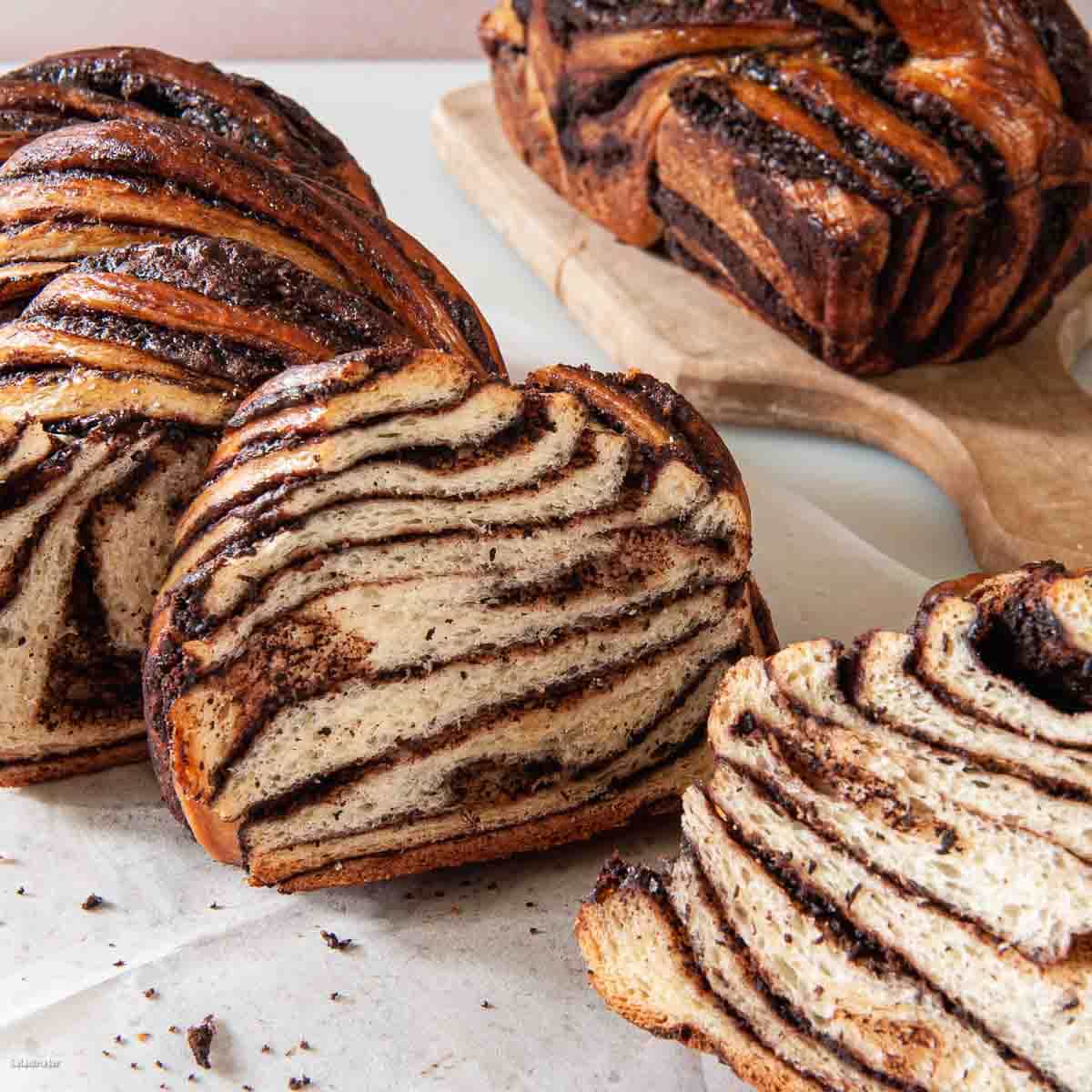
As an Amazon Associate, I earn from qualifying purchases.
You may wonder how on earth you can make a traditional chocolate babka with a machine. The answer is my usual, “Use the bread machine for what it does best (kneading and mixing), then shape it by hand and bake it in a conventional oven.”
Three Reasons Why You Don’t Want To Miss This Recipe
- Don’t worry. I’ll hold your hand. I’ve included lots of pictures and a video to help you be successful.
- Even if it doesn’t turn out beautiful the first time (practice helps), the recipe will still produce one of the best-tasting loaves to ever come out of your kitchen.
- Make this recipe using the DOUGH cycle on your bread machine. If you don’t have a bread machine, you can mix the dough in a stand mixer or by hand. See the notes in the recipe.
What Is Babka?
This sweet bread with Jewish roots has transformed over the years, boasting a variety of delectable fillings such as cinnamon and sugar, hazelnut, and, of course, chocolate. Whether you enjoy it for breakfast, brunch, dessert, or even as a snack, this heavenly treat will satisfy your cravings.
Like donuts and many homemade yeast bread recipes, Chocolate Babka is best eaten the day it’s made. However, a quick trip through the microwave makes it an irresistible snack for the next couple of days.
You can also make it and bake it beforehand since it freezes well. (Don’t miss the hint at the end of this post about slicing frozen Babka.)
How Long Does It Take To Make Chocolate Babka?
Some recipes claim to take all day. I’m not up for that, especially during the Christmas season. As you look through the steps in the recipe, note that most of the time, it is hands-off.
Grand total of time needed? Fewer than four hours. This does not include the recommended two-hour cooling time for the baked loaf.
Ingredients and Substitutions
Note: To ensure the best results, use a digital scale for accurate measurements. Trust me; it makes a difference, especially with the flour and liquid.
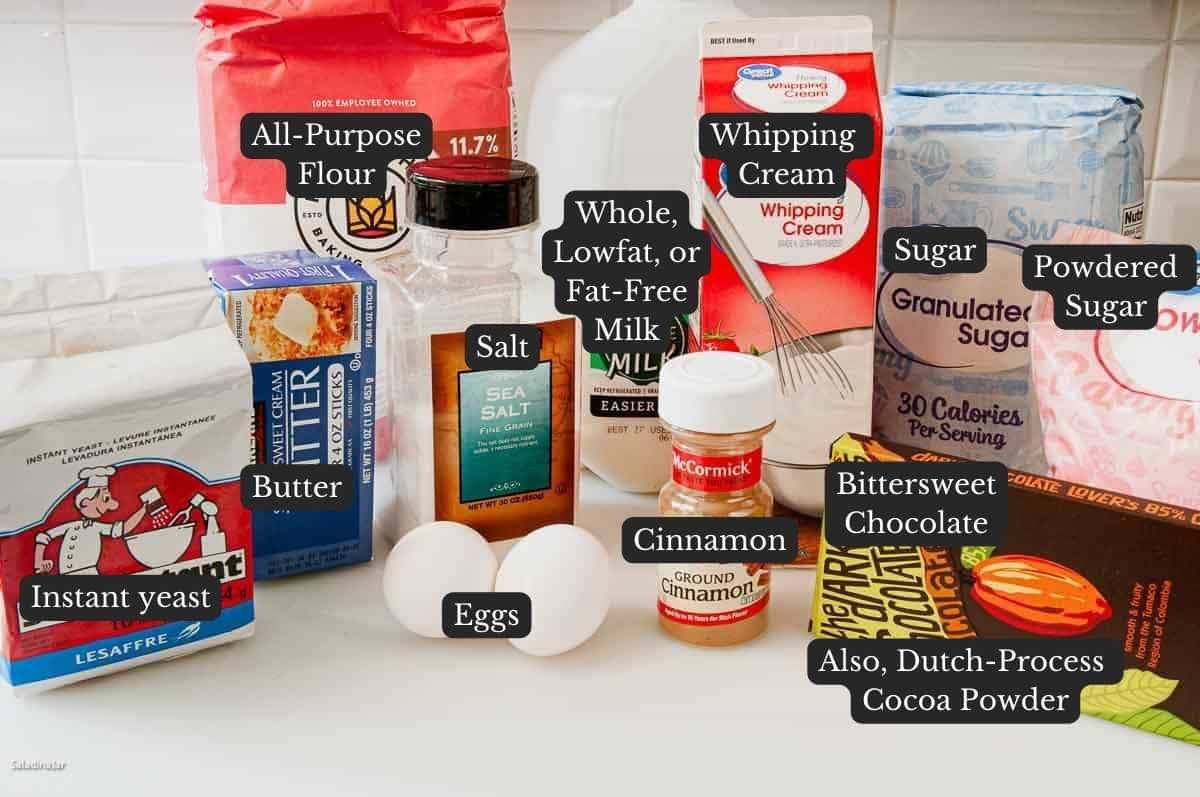
- Half and half: Half-and-half means half of the mixture is whole milk, and the other half is heavy or whipping cream. Use half and half, if possible. If you don’t have whole milk, use low-fat or non-fat milk. You could even use evaporated milk (but not sweetened condensed milk). I have not experimented with any substitutes for the cream. It’s the secret to the fabulous taste of this loaf and also makes it easier to handle.
- Please note: The milk does not need to be heated or allowed to come to room temperature when using a bread machine. The friction of the kneading paddles will warm the ingredients automatically.
- Sugar: In the dough recipe, I always use granulated sugar. I haven’t tried any substitutes.
- For the filling, I prefer powdered sugar. I tried granulated sugar, but it didn’t dissolve as I had hoped and made the filling grainy.
- Salt: Use a table or sea salt. If you want to use Kosher salt, add a ¼ teaspoon more.
- Eggs: I always buy large eggs. The average large egg measures 50 grams. If yours weighs more, or you want to use a different-sized egg, you may need to adjust the amount of flour while the bread is kneading in the machine. Like milk, the eggs do not need to be warmed when using a bread machine.
- Butter: I use unsalted butter in this recipe, but use whatever you have. I have not experimented with any substitutes for the butter–it’s just too good the way it is. There is no need to warm the butter. Chop cold butter into small pieces and add it along with the rest of the ingredients.
- Flour: Unbleached or bleached all-purpose flour works well. I do not recommend bread flour in this recipe because of the chewy texture it lends to bread. Better to weigh the flour with a digital scale instead of using measuring cups.
- Yeast: Use instant or rapid-rise yeast, and yes, add only 3/4 of a teaspoon. That’s the only kind of yeast I use in a bread machine.
- You can substitute active dry yeast, but I don’t recommend it. It is slower to rise and requires an extra step to dissolve it. The enrichments (butter, sugar, and eggs) will slow the rise down as it is.
- Chocolate: I use my favorite bittersweet chocolate from Trader Joe’s or Ghiradelli’s bittersweet baking chocolate. Substitute semi-sweet chocolate if you prefer.
- Cocoa: I use Ghiradelli’s Dutch-process powdered cocoa. I haven’t tested this recipe with regular cocoa.
Do I Need Any Special Equipment To Make This Recipe?
These items aren’t required (except the rolling pin), but they will make the process easier. These things are also helpful when making other bread recipes on this website.
- 8½ x 4¼-inch loaf pan: I love this one from USA Pans (paid link). A 9 x 4 x 4-inch Pullman pan(paid link) would also work. The one I linked to does not have a cover. If you want a cover, look here (paid link).
- Offset spatula: This knife-looking instrument (paid link) is much easier for spreading filling than a table knife or spatula. You’ll reach for it over and over if you frost cakes.
- A bread machine: Bread machines (paid link) are my thing. I use them for all of my bread recipes. See the recipe notes if you want to use a stand mixer or make this recipe by hand.
- Rolling pin: This recipe requires that you roll the dough very thin. This rolling pin (paid link) is similar to the one I always use.
- Bench Knife: A bench knife(paid link) is one way to cut the cylinder of chocolate-layered dough into two half-pipes. You can also use a pizza cutter or a sharp butcher knife.
- Parchment paper: Line your pan with parchment paper(paid link) to make it easier to remove the baked Babka from the pan.
- Quick-read digital thermometer: This is my all-time favorite digital thermometer(paid link) from Thermapen. I use it for something every day that I walk into my kitchen. This pocket thermometer(paid link) is smaller and less expensive but will do the trick. Here is an inexpensive digital thermometer(paid link) from Amazon. Read about all the ways you can use a thermometer to make fabulous bread.
- Silicone mats: I like to use an extra large silicone mat designed for rolling out pie crusts. See my trick below to “make-do” with two regular-sized silicone mats.
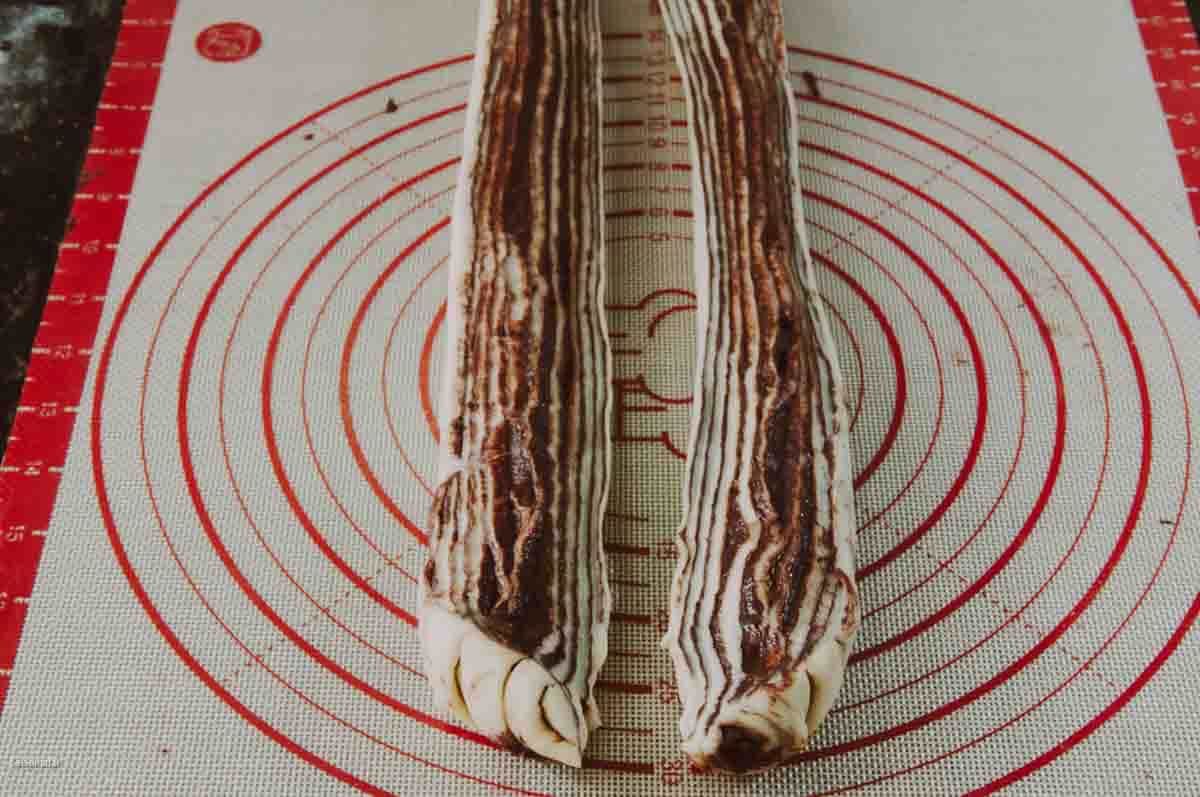
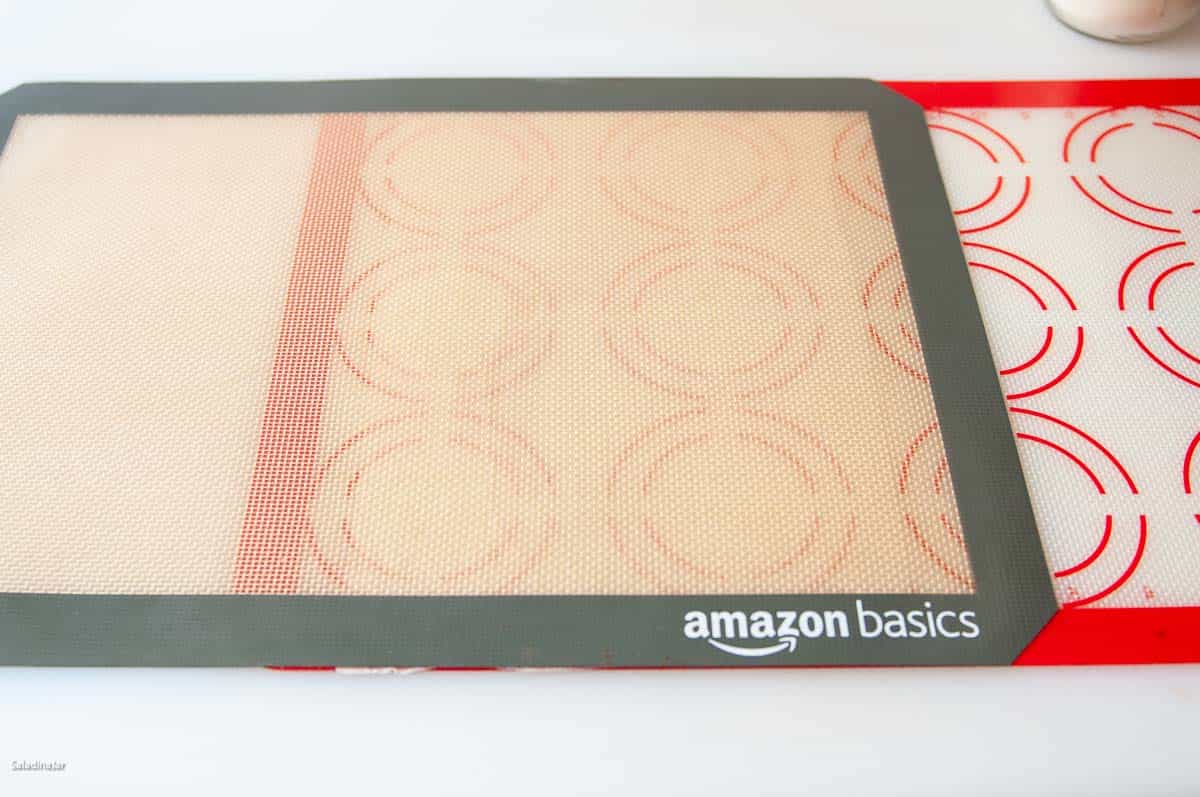
How To Make Chocolate Babka Dough in a Bread Machine
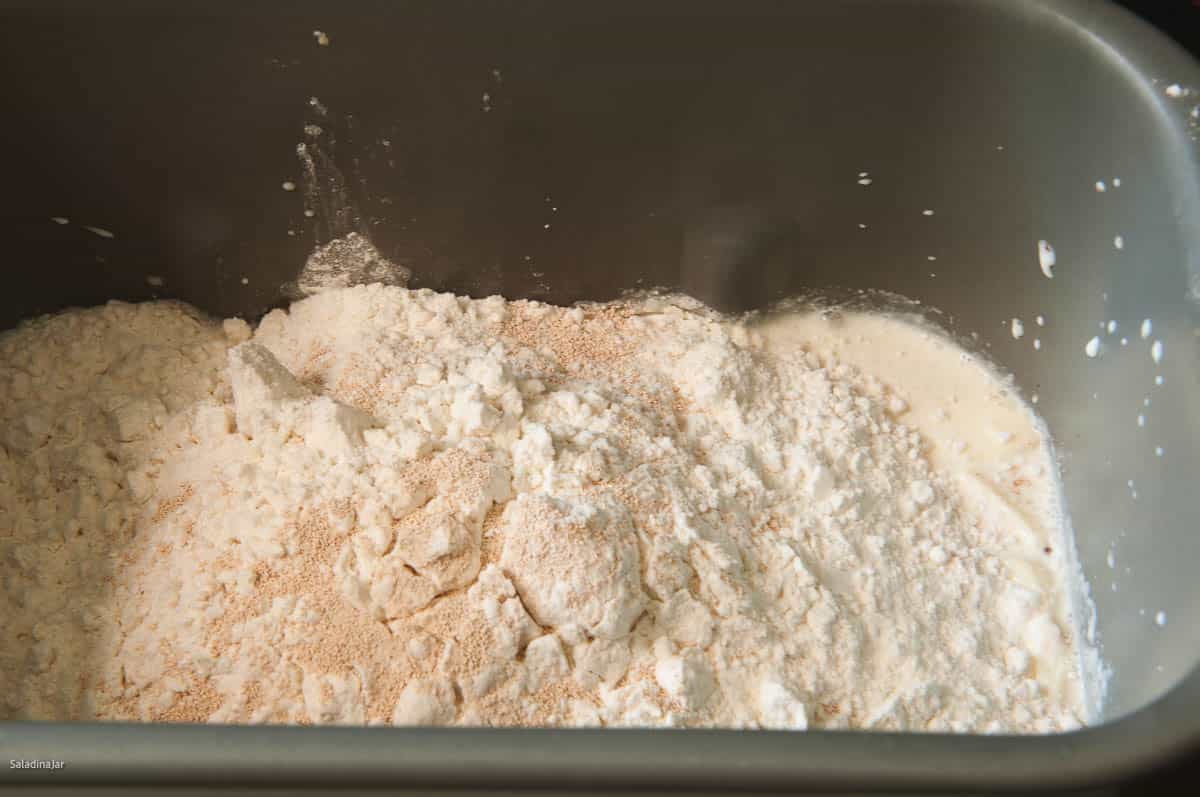
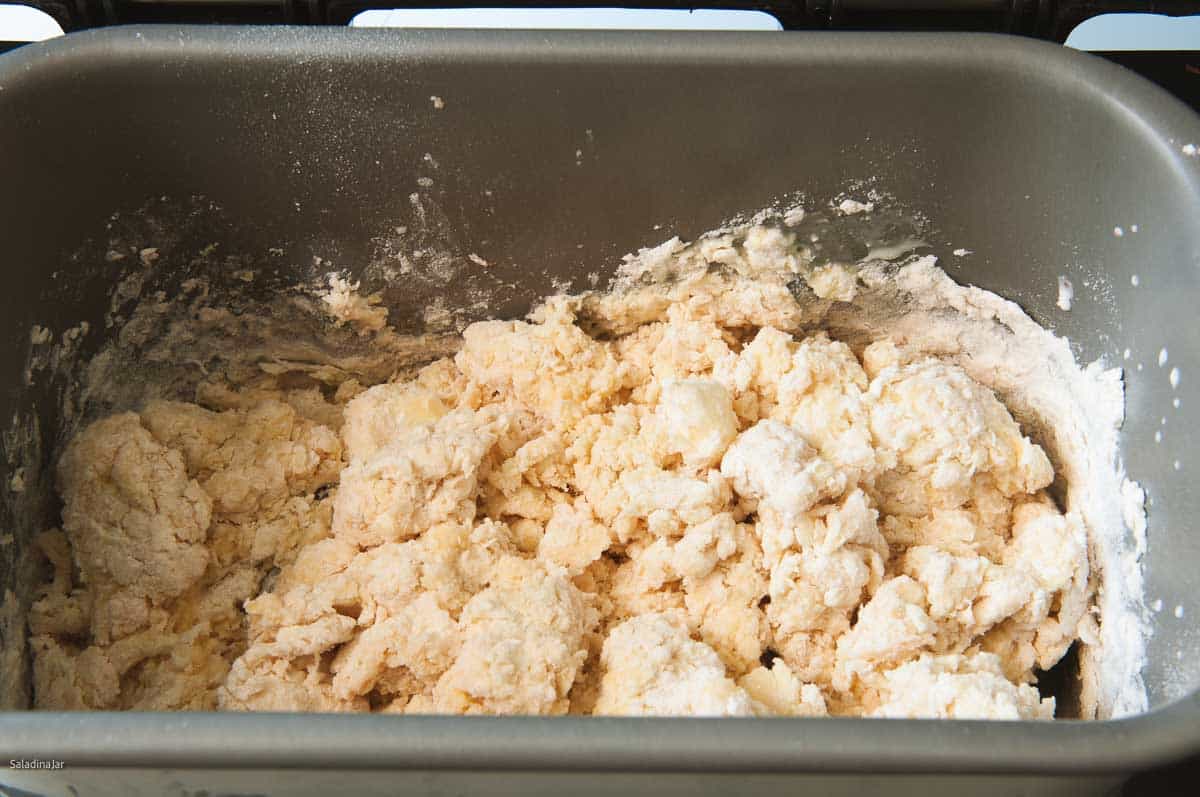
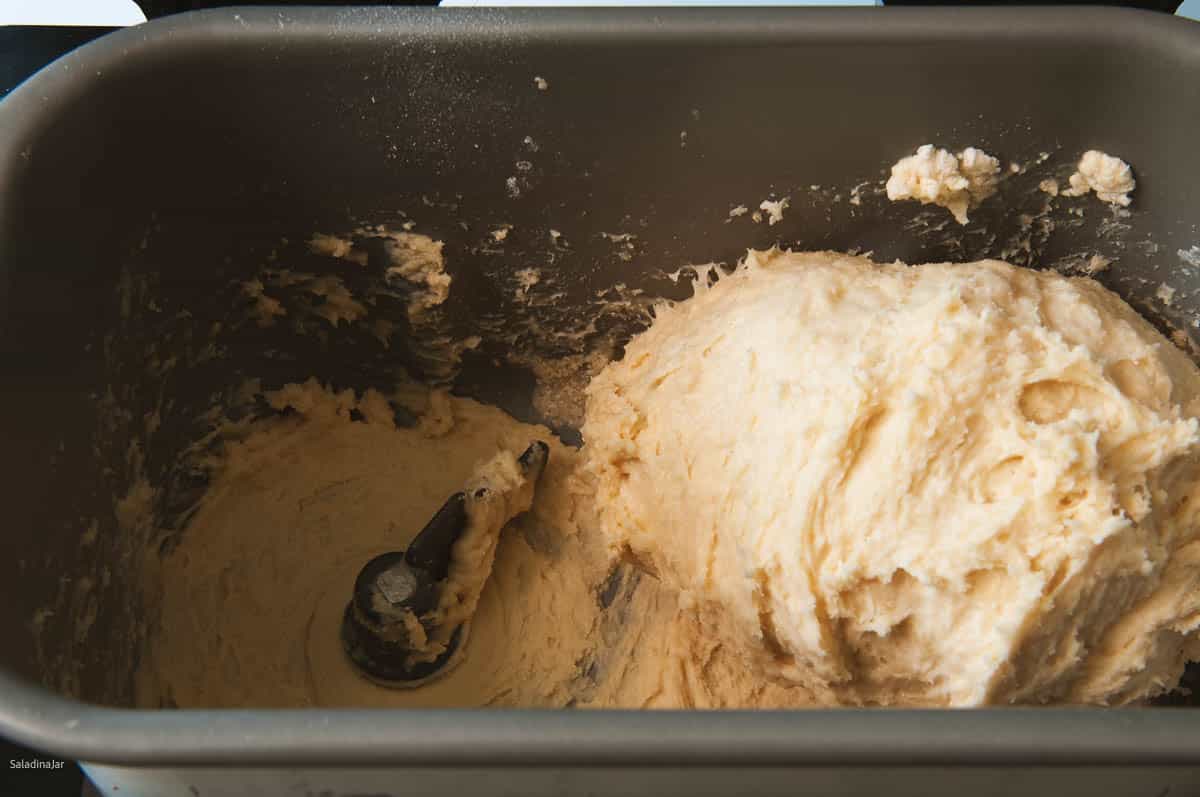
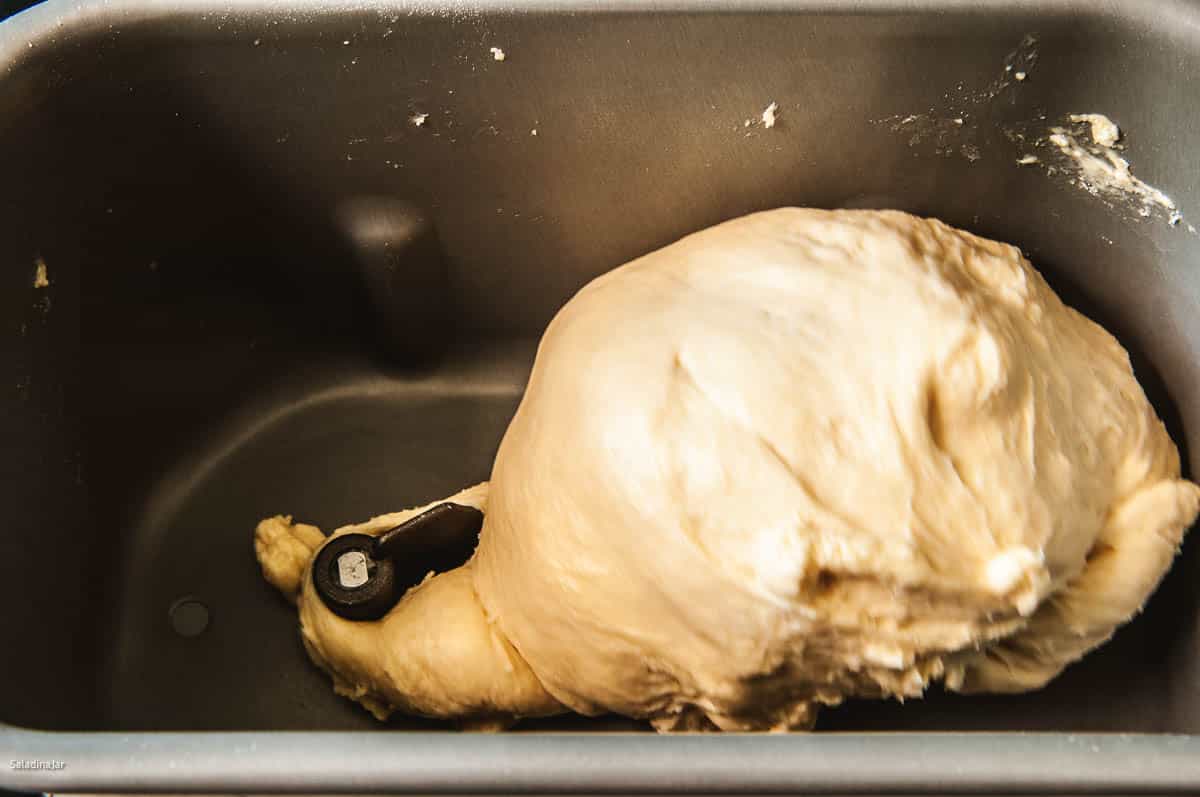
It should be tacky enough to stick to the sides, then pull away cleanly. If you have a smooth ball that bounces off the side, add a tiny amount of liquid. If the dough is so wet you can’t handle it, add a small amount of flour until it will pull away after sticking.
📌Kitchen Tip📌 The perfect time to make the chocolate filling, egg glaze, and sugar syrup is while the dough is mixing and rising in the bread machine pan. This gives plenty of time for them to cool before you shape the dough.
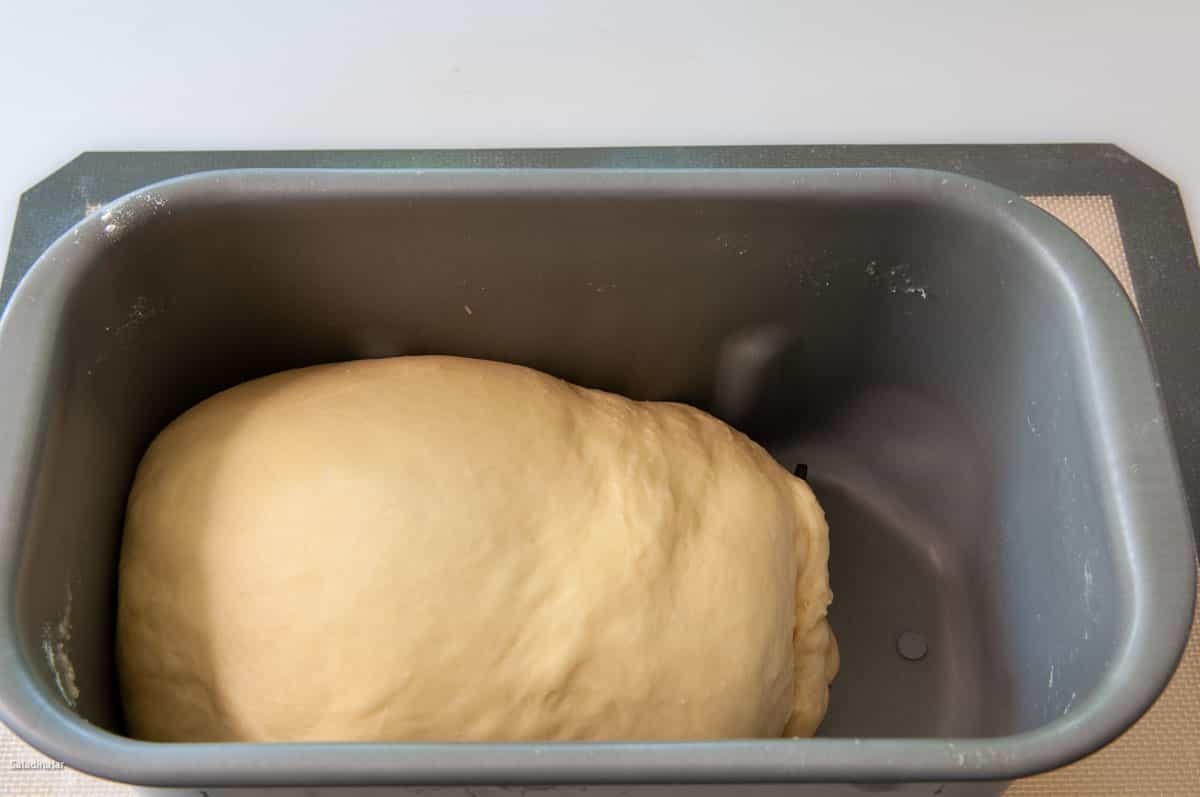
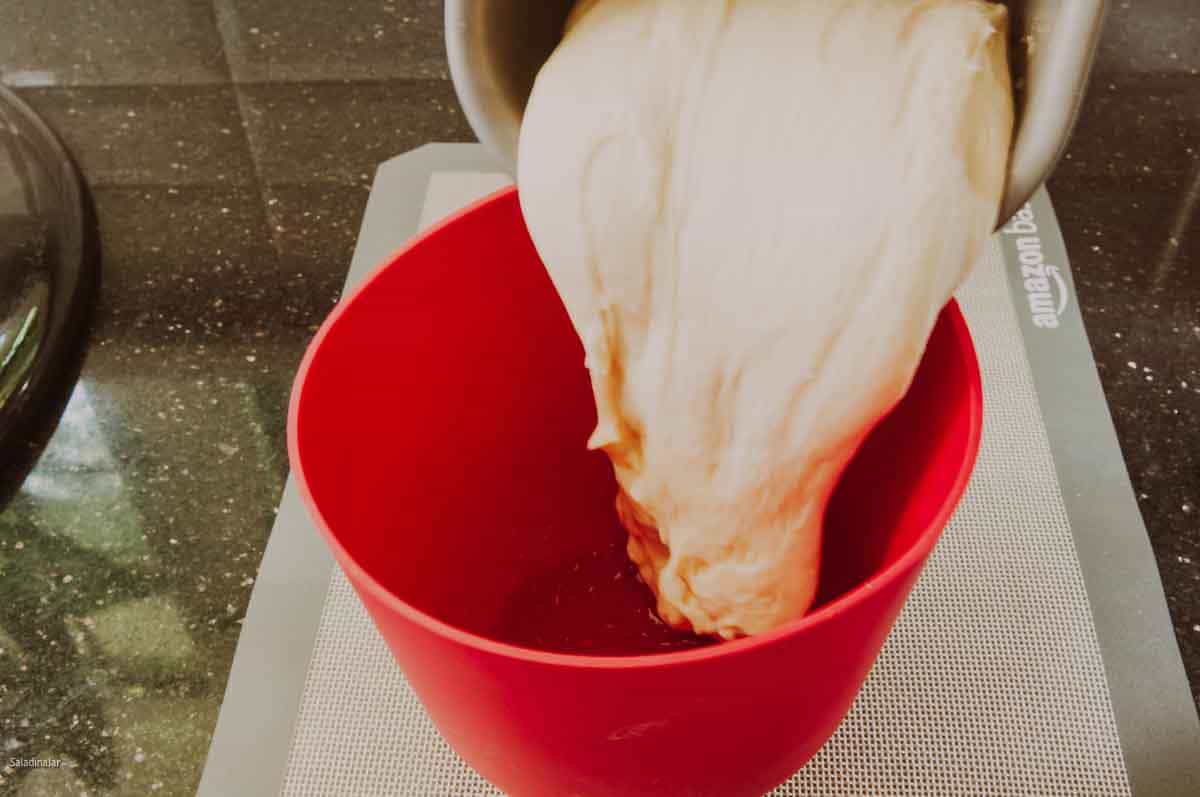
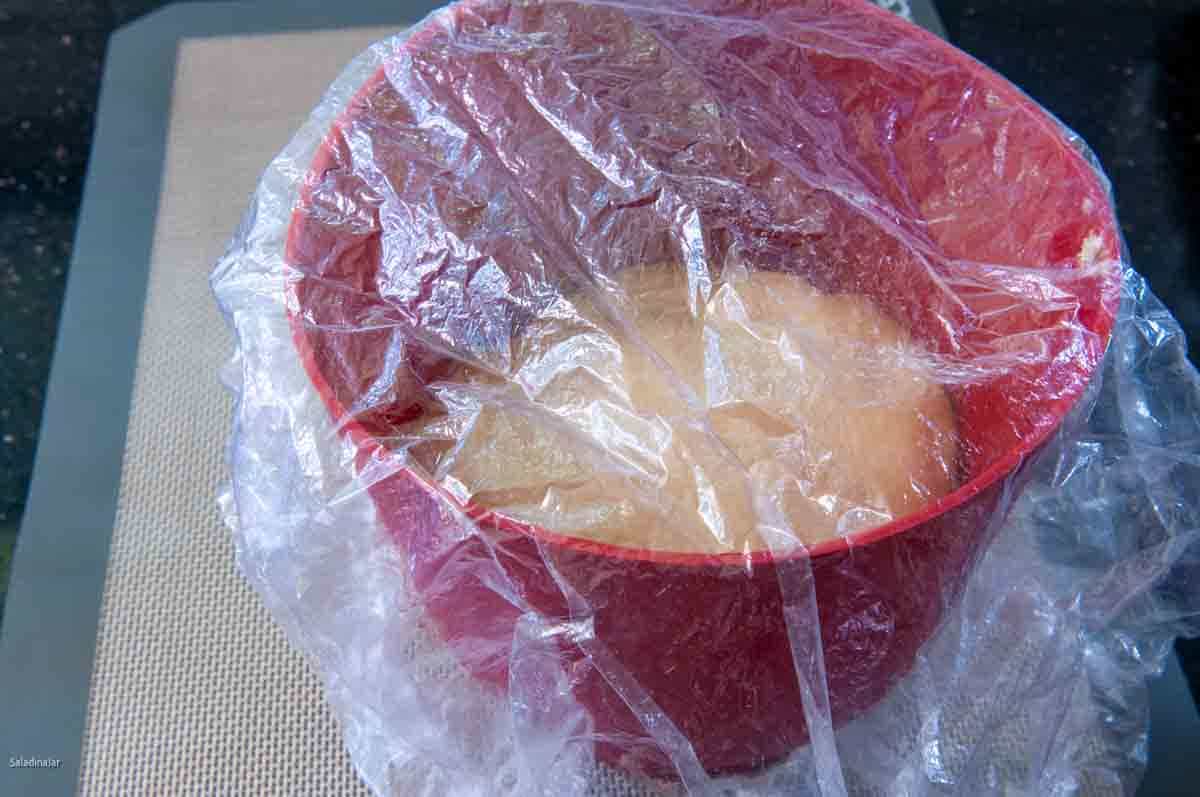
How To Shape Chocolate Babka By Hand
Preheat a conventional oven to 350˚F (170˚C).
If you have made my Cinnamon-Twist Bread, this is the same shaping technique. Incidentally, the dough is also the same, with a few tweaks.
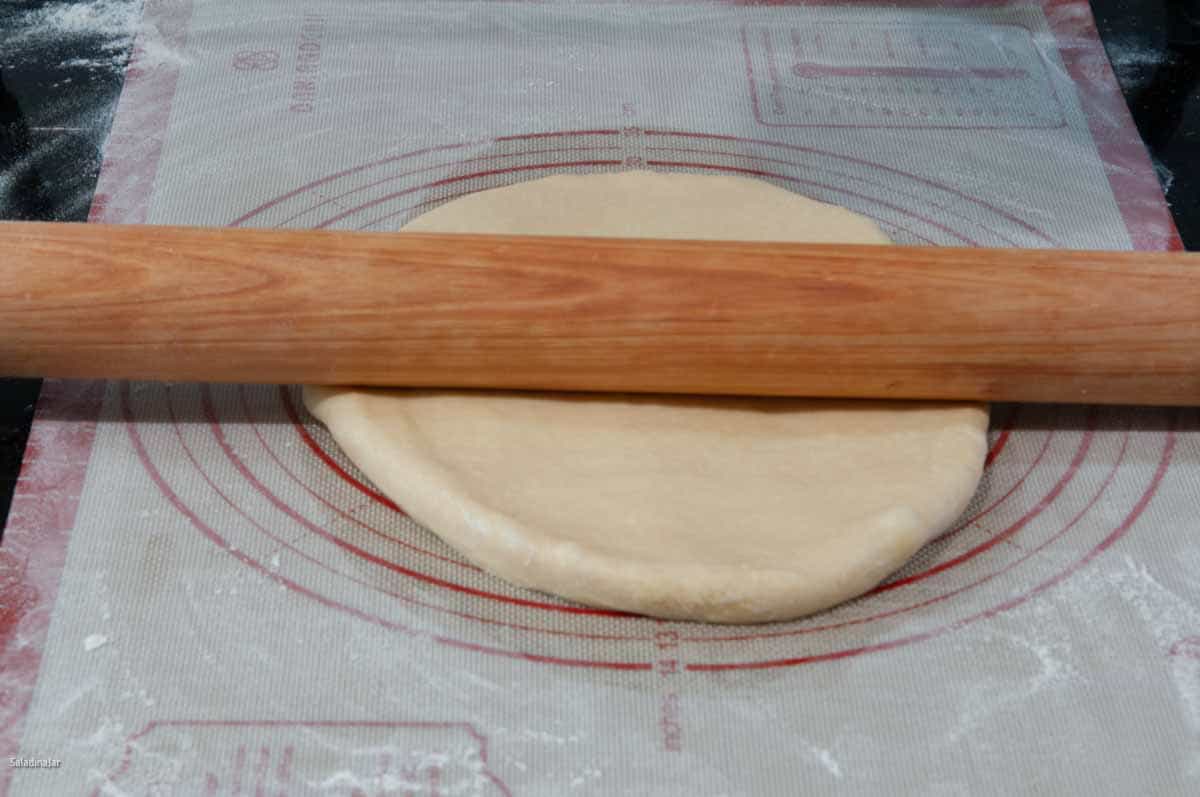
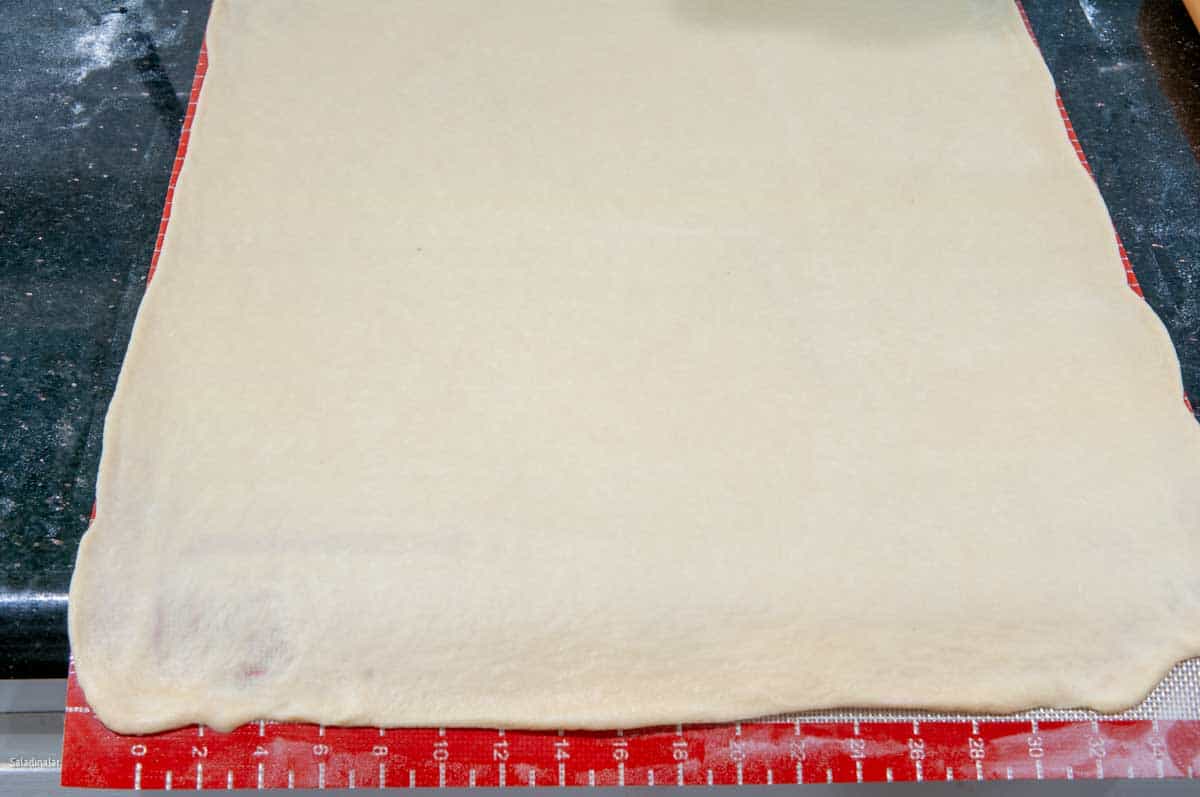
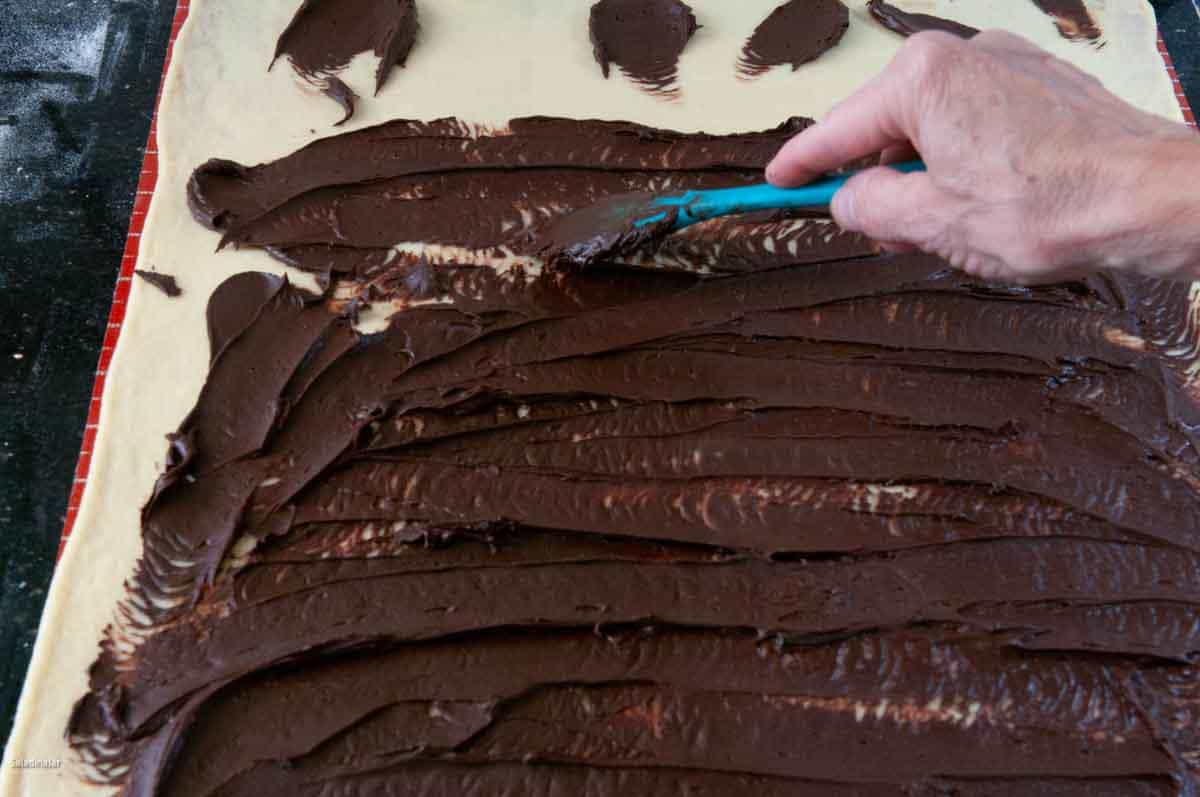
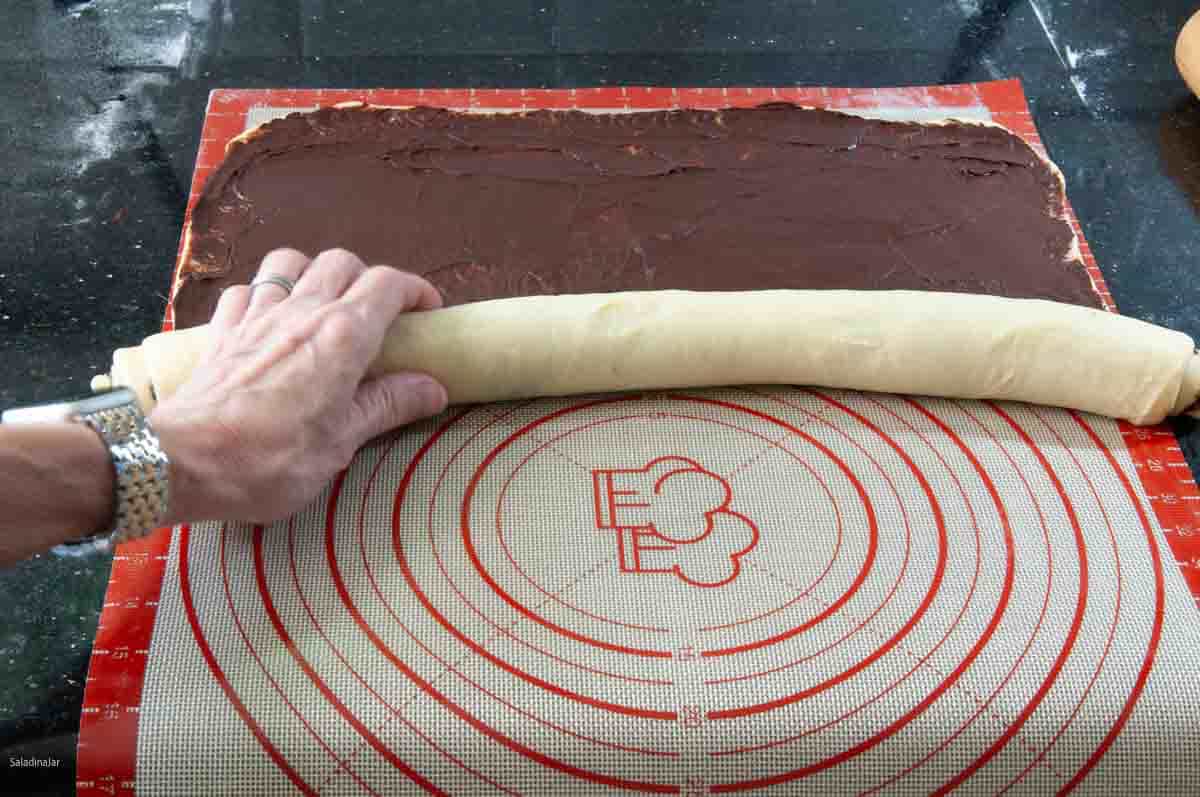
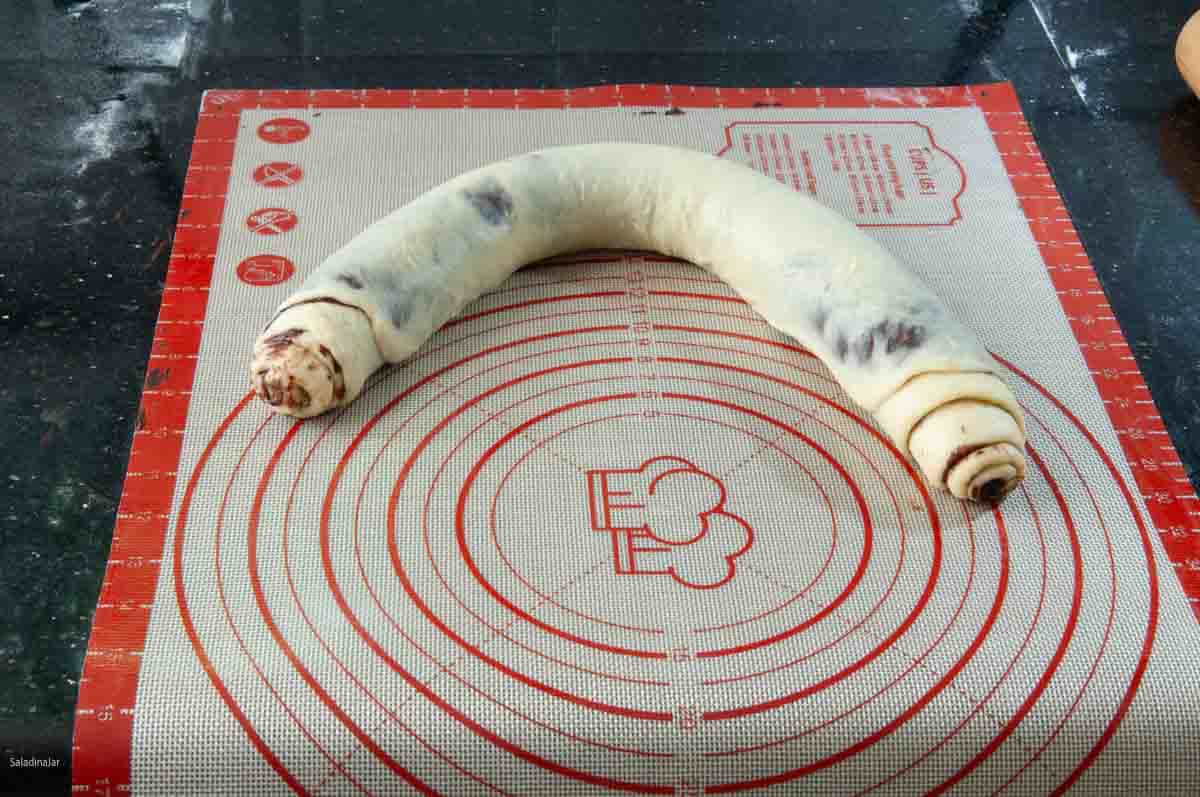
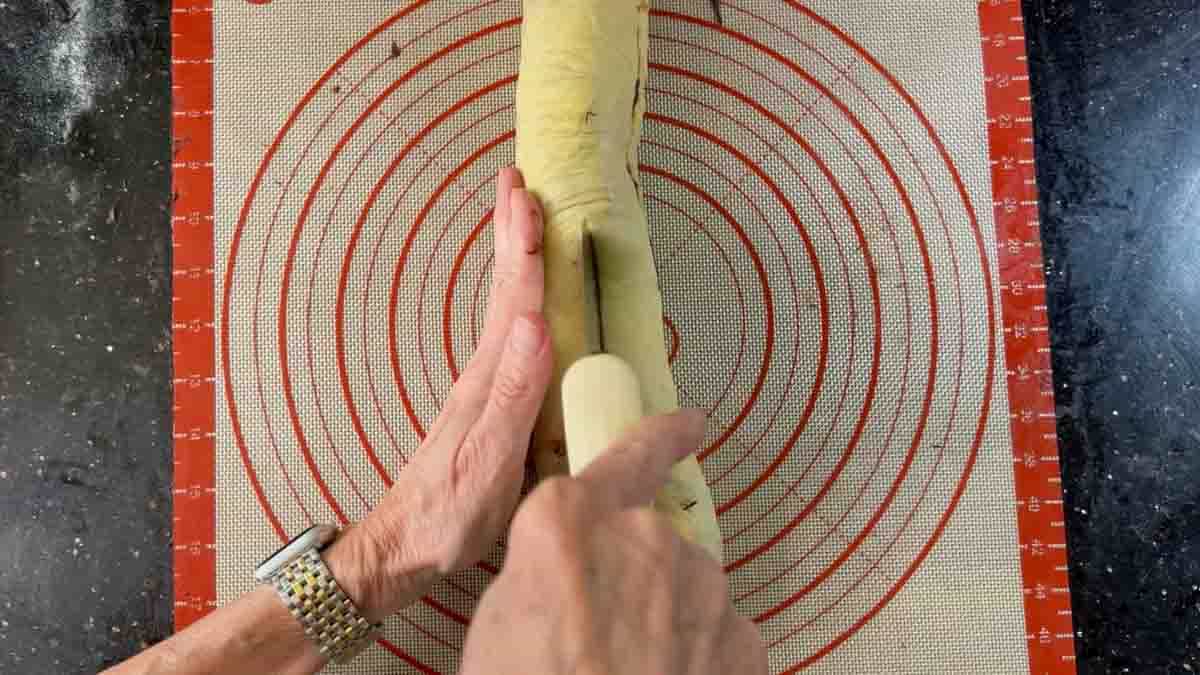
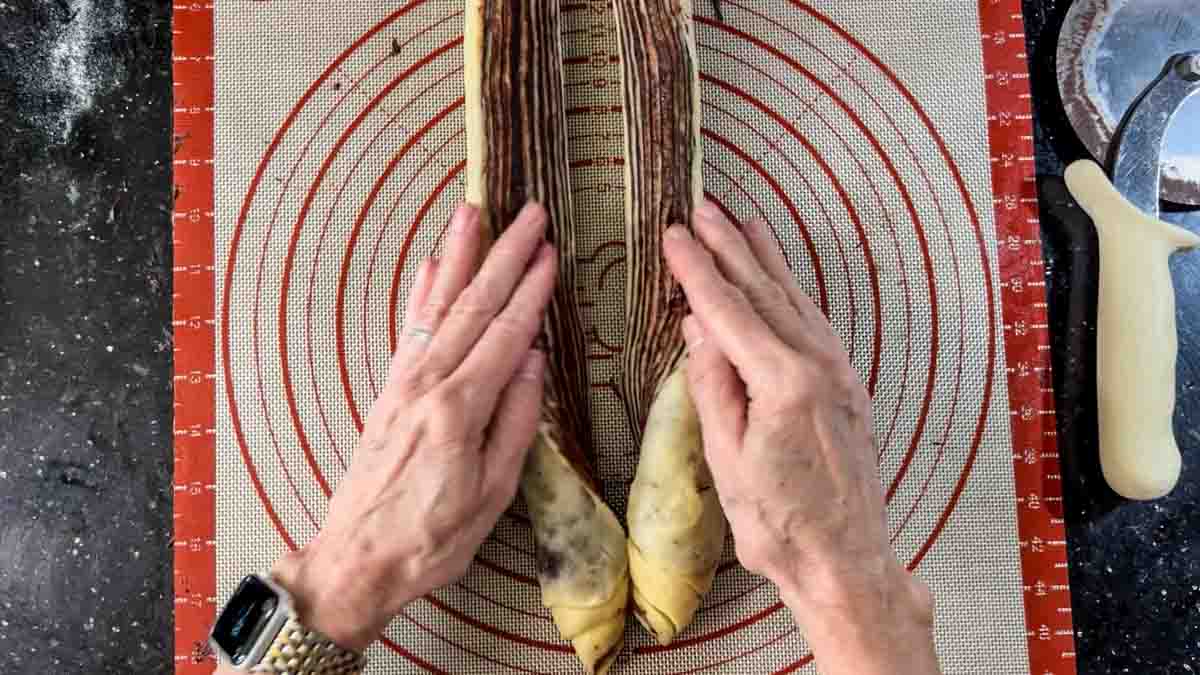
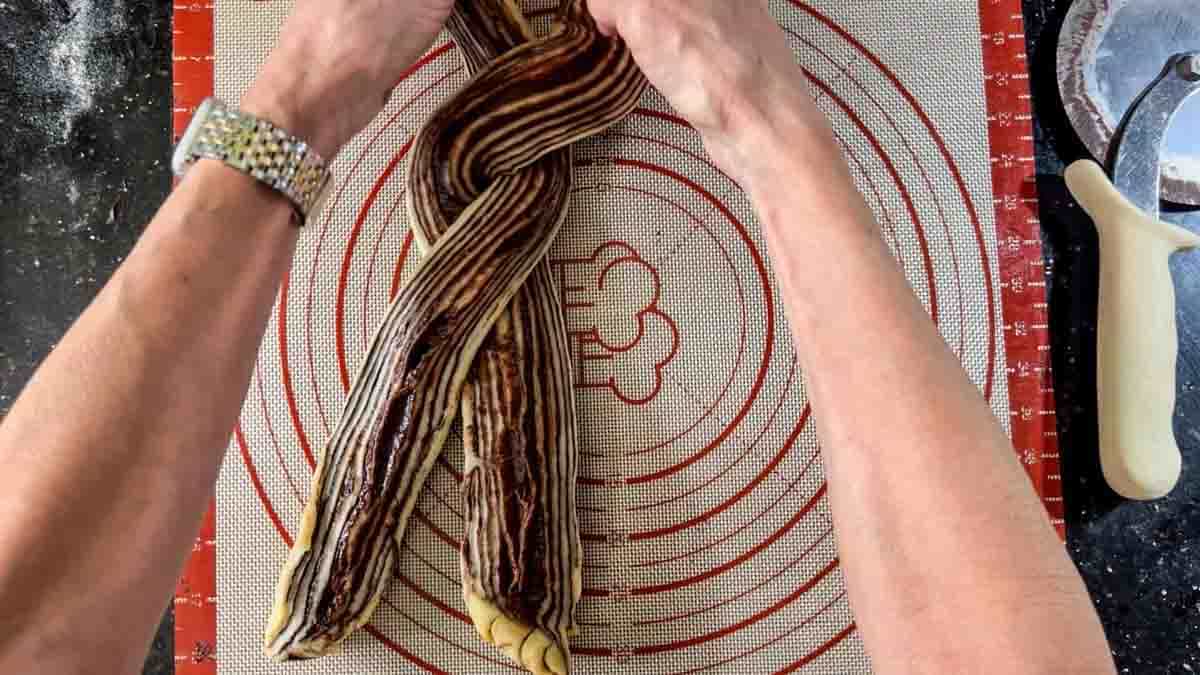
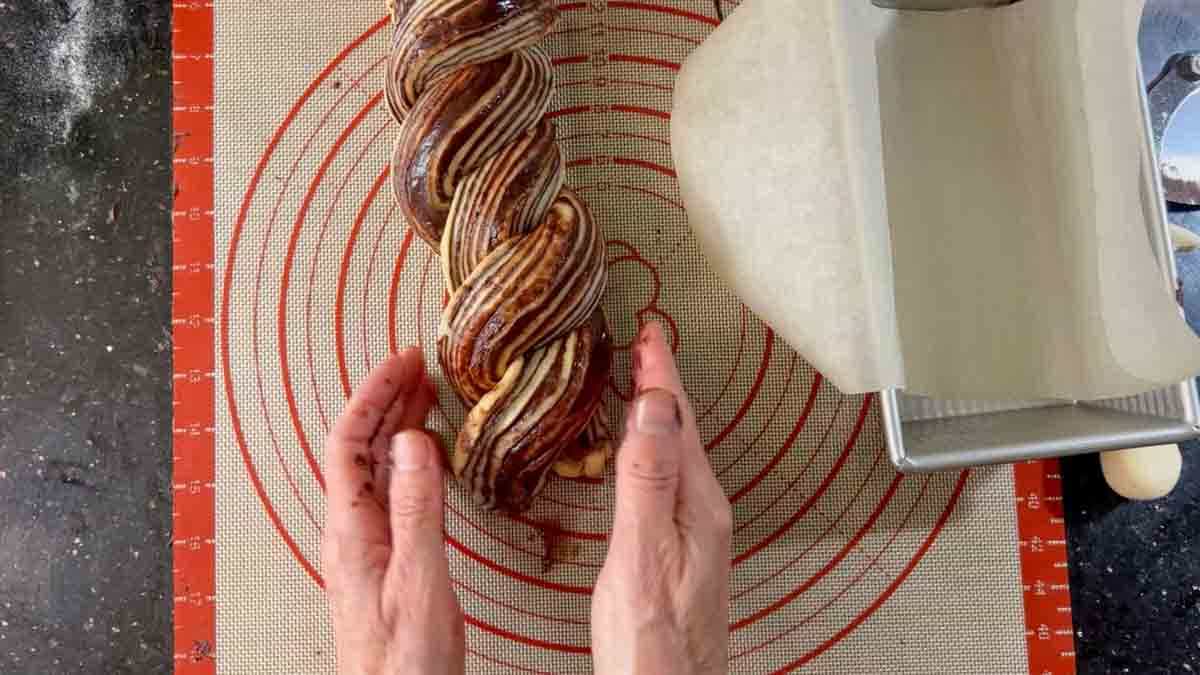
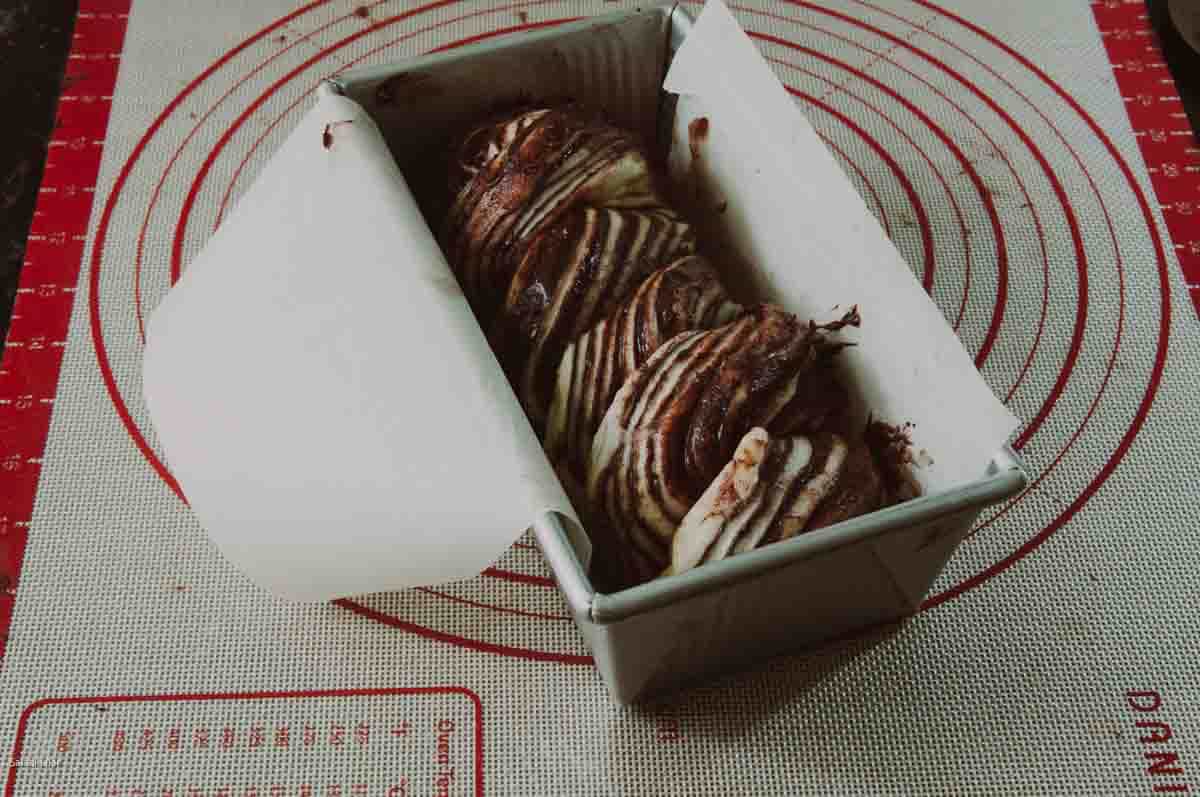
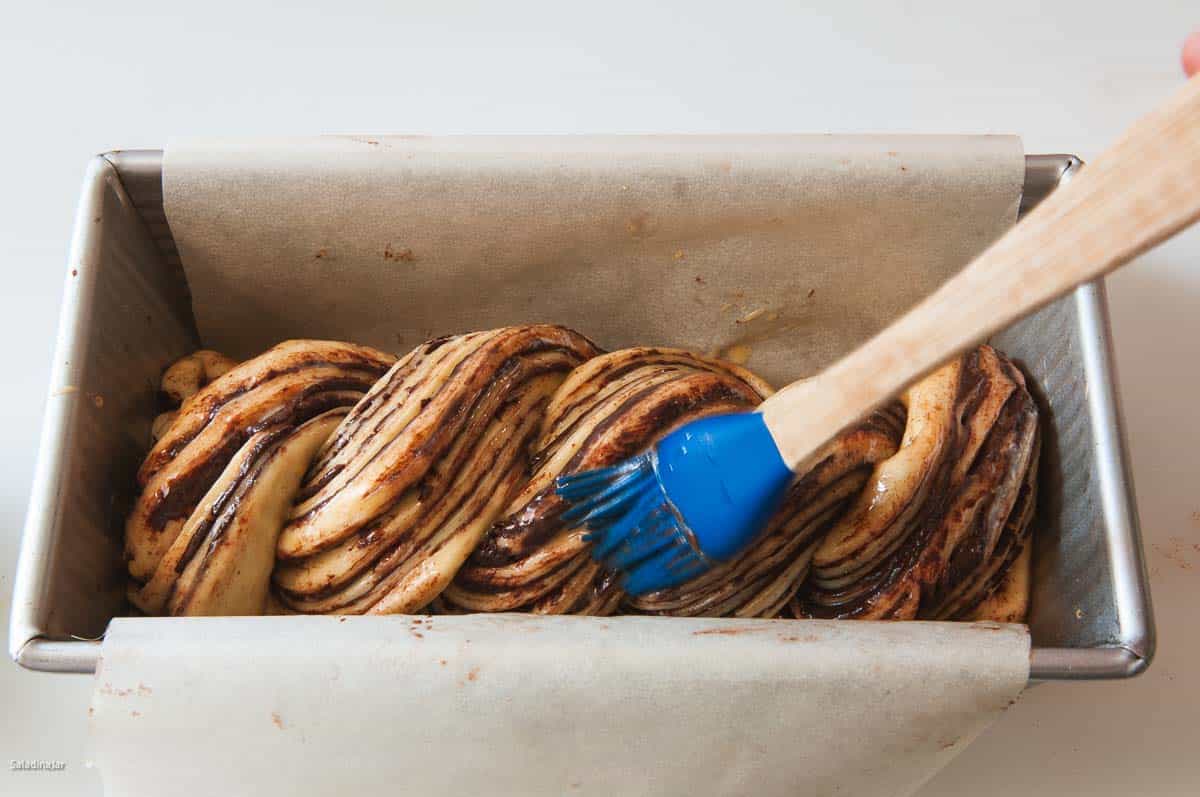
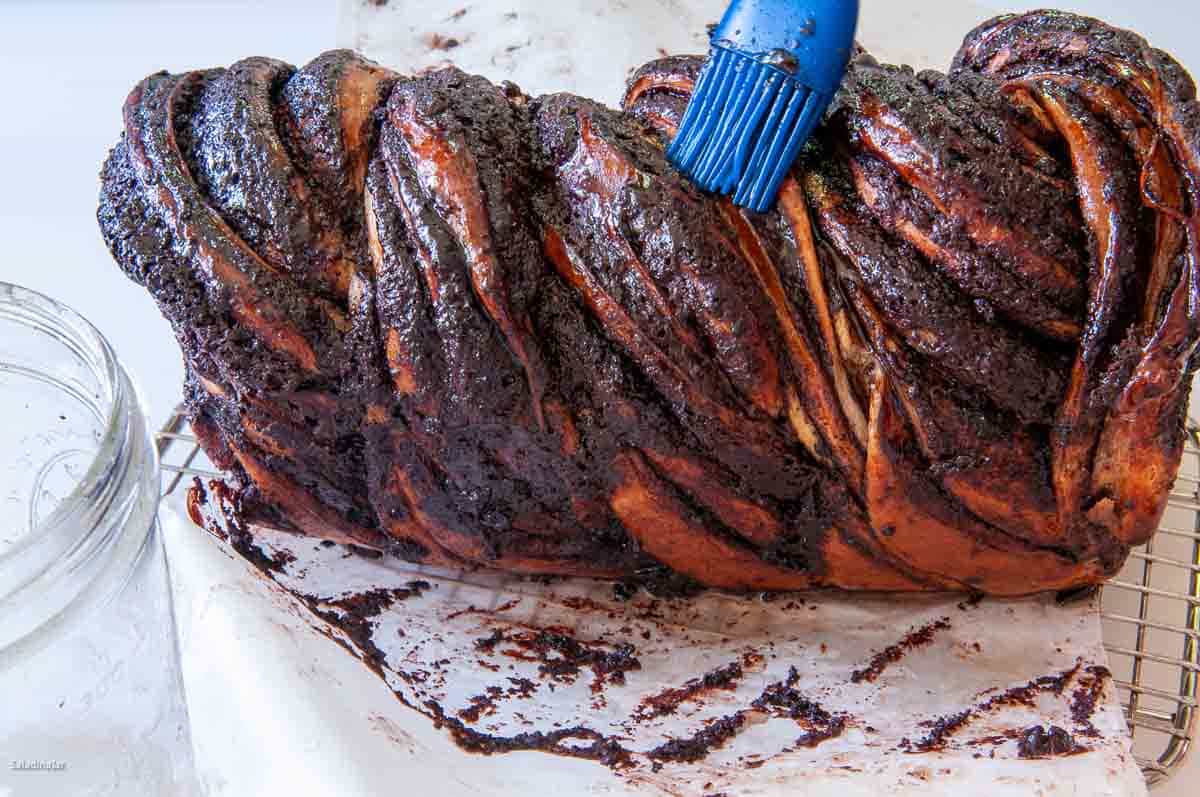
While the Babka is still warm, brush the sugar syrup all over the loaf. Allow to cool for 15 minutes in the pan. Turn the bread out onto a wire rack and let it cool for two hours before slicing.
📌Slicing tips📌
- I recommend allowing 2 hours for the loaf to cool before slicing. Otherwise, the layers may pull apart from the chocolate as it cools, leaving large spaces or holes between them.
- To get the prettiest slices, freeze the baked and cooled loaf. When frozen, allow the loaf to defrost just enough to slice the bread. Once sliced, the bread will thaw quickly and be ready to serve in minutes.
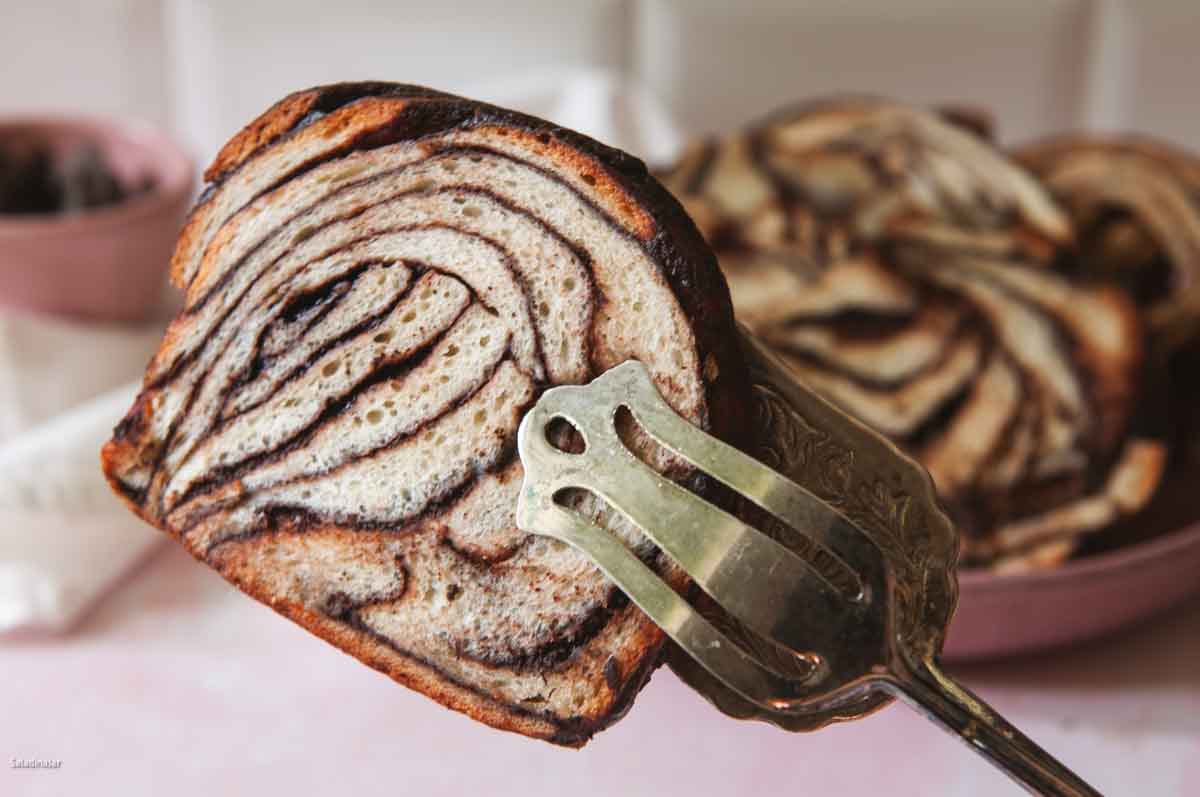
FAQs About Chocolate Babka Mixed in a Bread Machine
Babka is a sweet yeast bread that originated in the Jewish communities of Poland and Ukraine.
Babka is best eaten the day it’s made. Warmed up, it’s good for three days. Otherwise, freeze it for up to three months. Double-wrap to protect it from freezer burn.
I have not tried actually baking Babka in a bread machine because I don’t like to share bread with holes in the bottom and cardboard crusts. Using the DOUGH cycle of your bread machine and then baking in a conventional oven is the best plan for this recipe.
When the DOUGH cycle is done, remove the dough and shape it by hand. No final rise is needed. Bake immediately in your preheated conventional oven for a loaf you will be proud to share.
Yes. You won’t even need a teaspoon of instant yeast. Commercially-made Babka is made of extremely thin layers that are difficult for a home cook to reproduce. However, using small amounts of yeast and skipping the final rise after shaping helps to keep the layers thin.
It was undercooked. The best way to avoid this is to use a digital thermometer (every modern kitchen needs one) and bake the bread until the internal temperature reaches 190-195˚F, no matter what the timer says.
Let your Babka cool for at least two hours before slicing. If you want to eat it warm (I don’t blame you), the layers may fall apart.
Parting Thoughts: There are several ways to shape a Babka, and I tried a lot of them. I landed on this one as it seems easiest for beginners. But don’t expect the shape to be perfect the first time. Practice helps. If you enjoy making bread for special occasions, check out these recipes also mixed in a bread machine: Easy Bear Claw Recipe and Party Bread with Three Flavors.
Recipe Help at Your Fingertips: For questions or suggestions, email Paula at saladinajar.com. If you need help, I’m happy to troubleshoot via email (faster than leaving a comment). Attach pictures and as many details as possible for the best advice.

Chocolate Babka Recipe Made Simpler with a Bread Machine
Rate this recipe
(5 stars if you loved it)
Video
Ingredients
- ½ cup (114 g) half & half (or ¼ cup milk + ¼ cup heavy cream)
- 2 tablespoons granulated sugar
- ¾ teaspoon salt
- 2 large (100 g) eggs
- 3 tablespoons (42 g) unsalted butter (chopped)
- 2½ cups + 1 tablespoon (308 g) all-purpose flour
- ¾ teaspoon instant yeast
Filling:
- ⅓ cup (76 g) unsalted butter
- 2.5 ounces (70 g) bittersweet or semi-sweet chocolate
- ⅓ cup + 1 tablespoon (44 g) powdered sugar
- 3 tablespoons (15 g) Dutch-process unsweetened cocoa
- ⅛ teaspoon cinnamon optional
Egg Glaze:
- 1 large (50 g) egg
- 1 tablespoon water
- pinch table salt
Sugar Syrup:
- ¼ cup (50 g) granulated sugar
- ¼ cup (57 g) water
Instructions
Dough:
- Place all ingredients for the dough (in the order listed) ½ cup (114 g) half & half (or ¼ cup milk + ¼ cup heavy cream), 2 tablespoons granulated sugar, ¾ teaspoon salt, 2 large (100 g) eggs, 3 tablespoons (42 g) unsalted butter (chopped), 2½ cups + 1 tablespoon (308 g) all-purpose flour, and ¾ teaspoon instant yeast into the bread machine pan. Select the DOUGH cycle and press START.
- Open the lid during the first minute and check that the paddles are engaged and the dough clumps.
- After 15 minutes, check the dough for consistency. It should be tacky. Add flour one tablespoon at a time if the dough is too wet. Add water one teaspoon at a time if the dough is too dry. The dough should stick to the sides of the pan, then pull away. See this post for more details about this surprising secret to better bread in a bread machine.
- Once you have the dough started in the bread machine, prepare the filling.
Filling:
- Place ⅓ cup (76 g) unsalted butter and 2.5 ounces (70 g) bittersweet or semi-sweet chocolate in a microwave-safe bowl. Microwave on 50% power for 2 minutes until completely melted. Stir together in circles until smooth.
- Add ⅓ cup + 1 tablespoon (44 g) powdered sugar, 3 tablespoons (15 g) Dutch-process unsweetened cocoa, and ⅛ teaspoon cinnamon to the melted butter and chocolate mixture. Stir until smooth. Set aside to cool. If the mixture seems too thick to spread, whip it by hand to soften it. If you add liquid, it may become too soft and hard to manage.
Glaze:
- Combine 1 large (50 g) egg, 1 tablespoon water, and a pinch table salt in a small bowl. Whisk until smooth.
Sugar Syrup:
- Combine ¼ cup (50 g) granulated sugar and ¼ cup (57 g) water in a small microwave-safe bowl. Don’t stir. Microwave on HIGH for 2 minutes or until the sugar is dissolved. (Stovetop method: Boil this sugar-water mixture on your stove-top for 2 minutes or until the sugar dissolves. Don’t stir while it cooks.)
Shaping:
- When the DOUGH cycle finishes, remove the dough from the bread machine pan to a greased bowl. Compress the dough by hand. Cover. Chill for at least 30 minutes or overnight.
- Remove the dough from the fridge and roll it into a 26 x 16-inch rectangle or as thin as possible without making holes. Spread the chocolate filling to the edges on all but the short side farthest away from you. An offset knife or small silicone spatula will help spread the chocolate evenly.
- Begin with the short side closest to you and shape the dough like a jellyroll. Roll the dough tightly, but don’t stretch the dough. Once rolled, pinch the seam to seal. Place the roll into the freezer for 10 minutes to make the next step easier. (If you are using a silicone mat, use it to hold and transfer the roll to the freezer.)
- Remove the roll from the freezer. Use a bench knife, pizza cutter, or large knife to slice the roll in half lengthwise. Try not to backtrack.
- Place the halves parallel to each other and side by side with the cut surfaces facing up. Pick up one half and drape it across the middle of the other half. Take the half underneath and drape it over the top. Continue twisting as you work towards each end. (See the video.)
- Place the twisted dough into a nonstick or greased 8½ x 4½ loaf pan. If it is too long, compress the twisted dough from each end to make it fit.
Baking:
- As soon as you finish shaping your loaf, preheat your conventional oven to <strong>350</strong> °F (180˚C). You will not let the loaf rise until it doubles like a traditional bread recipe.
- Brush the loaf with the egg glaze.
- As soon as your oven comes to temperature, bake for 40-45 minutes or until the internal temperature of the bread reaches 195-200 °F. (90-93˚C). Brush with sugar syrup immediately after removing the bread from the oven.
- Let stand in the pan for 30 minutes and transfer to a cooling rack for another hour before slicing.
Notes
- To make this recipe in a heavy-duty stand mixer: Add ingredients to the bowl in the same order. Turn on LOW to mix until all ingredients are moistened. Then, using a dough hook, turn the speed to 2 or 3. Continue beating/kneading until dough becomes smooth and elastic (about 5-10 minutes). Cover and allow to rise in a warm place. Deflate dough gently and shape as indicated in the recipe.
- If making by hand: Combine all ingredients into a shaggy ball in a large bowl. Turn dough out onto a floured surface. Knead with your hands until the dough becomes smooth and elastic. Kneading will likely take 10-20 minutes, depending on your experience. Place the dough ball into a greased bowl. Cover and allow to rise until double. Deflate the dough gently and shape as indicated in the recipe.
- Please note: If you only have active dry yeast, use 1/4 teaspoon more than called for in the recipe. It no longer needs to be dissolved first, but you can if you prefer.
Equipment
Nutrition
All images and text ©️ Paula Rhodes for Salad in a Jar.com

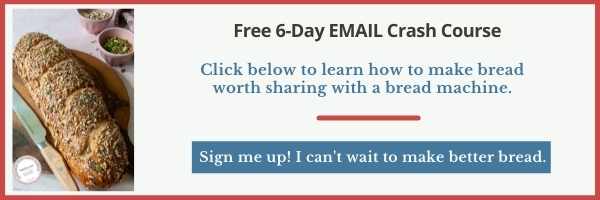

Paula Rhodes, owner
As a retired home economist, I created Saladinajar.com to share my belief that you don’t have to be a chef to find joy in creating homemade food worth sharing. Bread machines (used in an unconventional way), homemade yogurt, and quick microwave recipes are my specialty.